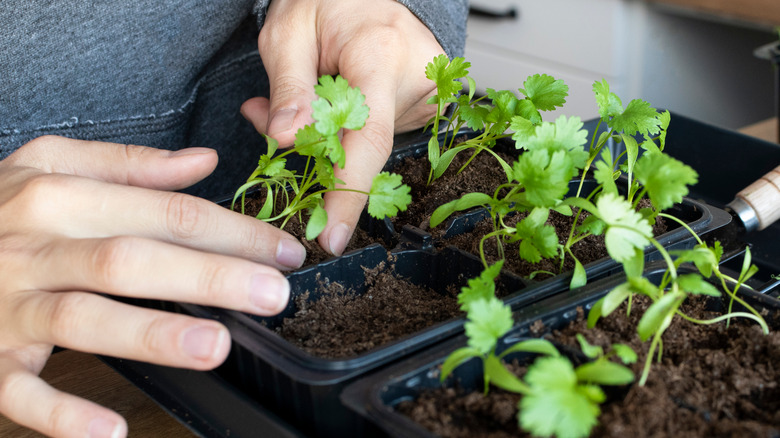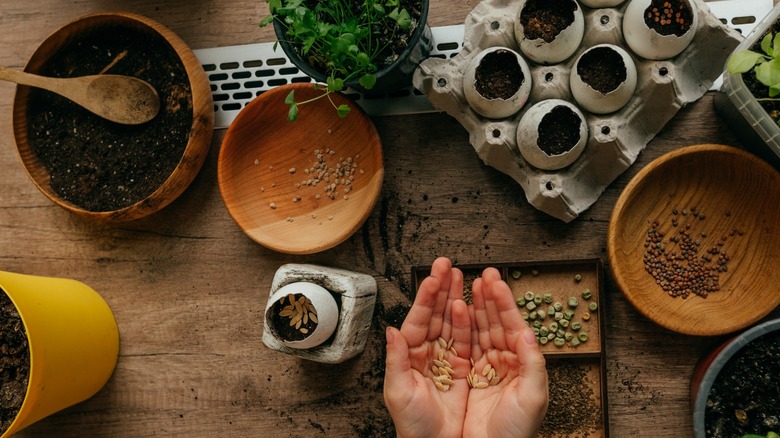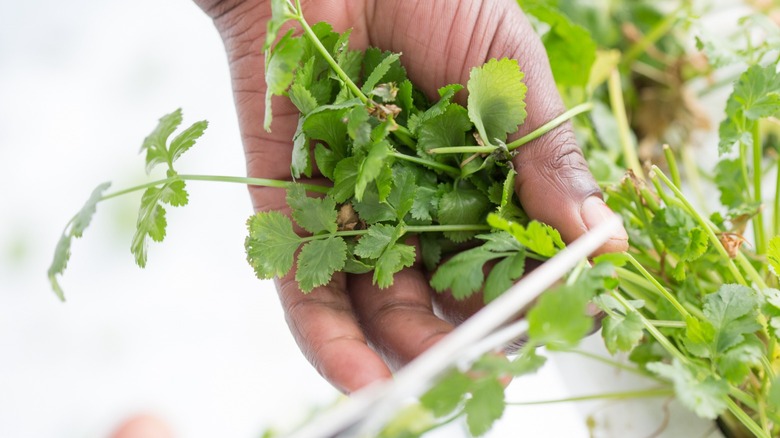The Best Method For Growing Cilantro Indoors
Growing herbs on a windowsill is a wonderful way to start a little garden indoors, even if you don't have one outdoors. Cilantro is an herb that's completely edible — from seeds and roots to leaves and stems — with each one having its own unique flavoring purposes. You can choose to grow it for microgreens, for full-grown leaves, or to be a flowering, seed-producing plant. There are several methods for growing cilantro indoors, including hydroponics and grow tents. We're going to talk about the easiest method of simply using the windowsill — just plant your seeds in a well-draining potting mix and cover them until the first leaves appear.
If you live in the southern hemisphere, a north-facing window is best. If you live in the northern hemisphere, choose a south-facing window if possible. One important thing to remember is you don't want your cilantro to bolt and flower, which basically ruins the flavor of the plant. Watering too little can cause this to happen, as can temperatures above 75 degrees Fahrenheit, so be careful of these possible pitfalls.
Choosing a container to sowing seeds
The first step is choosing the right container. In this case, choose one about eight inches in diameter with plenty of drainage. You can choose whether you want to traditionally water or try bottom watering — either way is fine with cilantro, as long as it has plenty of drainage. Next, choose potting mix for indoor herb growing. It's important to get the right kind so that it holds the right amount of moisture. Typically, it will be a mix of compost and vermiculite. Fill your container to about an inch and a half from the top with the potting mix.
The day before planting, put the seeds in a bowl and cover them with water. Soak them for about 24 hours to quicken germination then drain just prior to planting. The next part is important. Plant three seeds in a triangle in the middle of each eight-inch pot, about 1/4-inch deep. Cover them with a scattering of soil and then lightly mist the surface of the soil with a spray bottle. You can cover them with plastic wrap until they sprout.
Thinning to harvest
The next step is survival of the fittest. Once your seedlings get about one to two inches tall, they will produce a second set of leaves. At this time, evaluate the three plants and choose the strongest specimen. You can grind up the other two and use them for flavoring or throw them in the compost pile.
New seedlings need about five hours of natural sunlight per day, or you can also supplement by using a grow light if necessary — for every hour of sunlight, substitute two hours under a grow light. Remember to turn the plants about half a turn every three days or so for even sun distribution. Give them a water-soluble fertilizer that's diluted to about half-strength once a week while growing. Always keep the soil moist, checking it every couple of days.
In about five to seven weeks, your cilantro should be healthy, strong, and ready for its first harvest. The outside leaves are the oldest, so those are the ones to use first. Never harvest more than 30% of the plant at one time. Also, wait at least one week between harvests, and always cut the stems close to the base. Once you get a taste of fresh cilantro you grew yourself, you'll never buy it in the store again!


